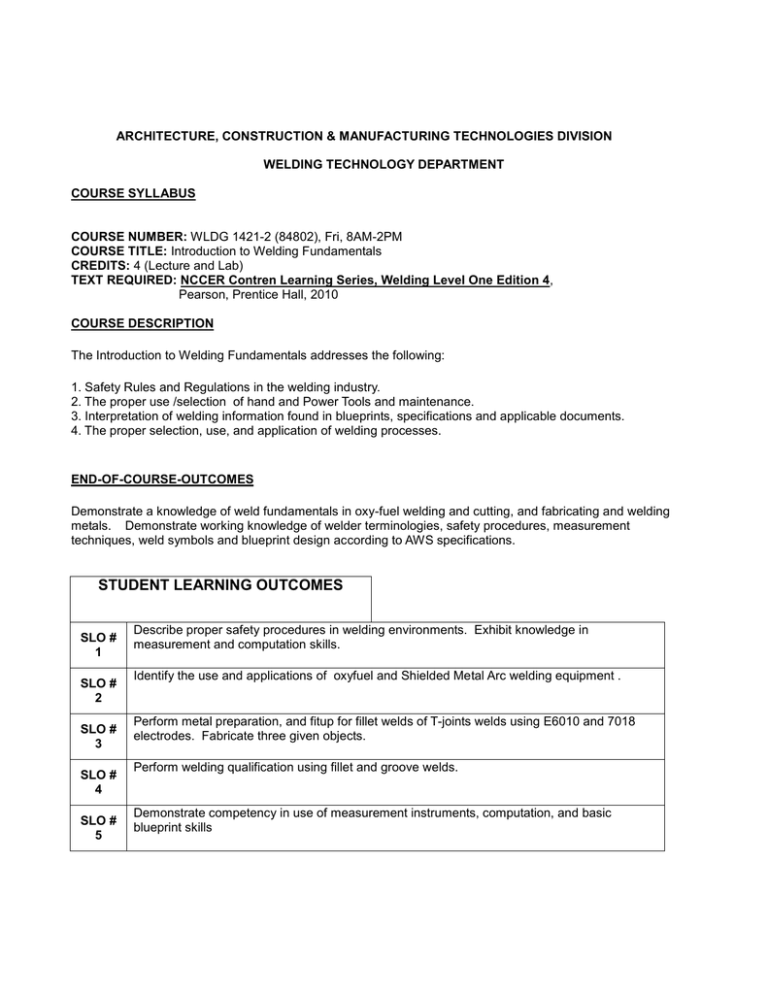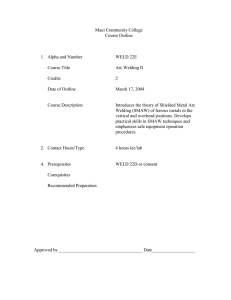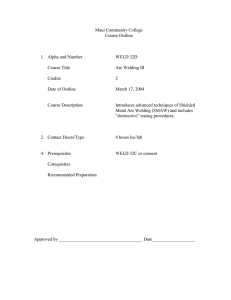
ARCHITECTURE, CONSTRUCTION & MANUFACTURING TECHNOLOGIES DIVISION
WELDING TECHNOLOGY DEPARTMENT
COURSE SYLLABUS
COURSE NUMBER: WLDG 1421-2 (84802), Fri, 8AM-2PM
COURSE TITLE: Introduction to Welding Fundamentals
CREDITS: 4 (Lecture and Lab)
TEXT REQUIRED: NCCER Contren Learning Series, Welding Level One Edition 4,
Pearson, Prentice Hall, 2010
COURSE DESCRIPTION
The Introduction to Welding Fundamentals addresses the following:
1. Safety Rules and Regulations in the welding industry.
2. The proper use /selection of hand and Power Tools and maintenance.
3. Interpretation of welding information found in blueprints, specifications and applicable documents.
4. The proper selection, use, and application of welding processes.
END-OF-COURSE-OUTCOMES
Demonstrate a knowledge of weld fundamentals in oxy-fuel welding and cutting, and fabricating and welding
metals. Demonstrate working knowledge of welder terminologies, safety procedures, measurement
techniques, weld symbols and blueprint design according to AWS specifications.
STUDENT LEARNING OUTCOMES
SLO #
1
SLO #
2
SLO #
3
SLO #
4
SLO #
5
Describe proper safety procedures in welding environments. Exhibit knowledge in
measurement and computation skills.
Identify the use and applications of oxyfuel and Shielded Metal Arc welding equipment .
Perform metal preparation, and fitup for fillet welds of T-joints welds using E6010 and 7018
electrodes. Fabricate three given objects.
Perform welding qualification using fillet and groove welds.
Demonstrate competency in use of measurement instruments, computation, and basic
blueprint skills
COURSE POLICIES
Attendance
Students are expected to attend classes regularly, and to be on time for every class period. Students can be
dropped from a class due to excessive absences. Excessive tardiness may be considered absences. Students
are responsible for subjects, assignments, and projects covered during their absences. Consult the Student
Handbook for more details or visit http://www.hccs.edu/hccs/current-students/student-handbook.
Students will be required to be present the entire class period. To be condidered present, student must be
present at roll call which will occur 1/2 hour before the end of class.
Academic Honesty
Scholastic dishonesty is treated with the utmost seriousness by the instructor and the College. Academic
dishonesty includes, but it is not limited to the willful attempt to misrepresent one’s work, cheat, plagiarize, or
impede other students’ scholastic progress. Consult the Student Handbook for more details.
Students with Disabilities
Any student with a documented disability (e.g. physical, learning, psychiatric, vision, hearing, etc.) who needs to
arrange reasonable accommodations must contact the Disability Support Services Office at his / her
respective college at the beginning of each semester. Faculties are authorized to provide only the
accommodations requested by the Disability Support Services Office. For Central College, call 713 – 718 –
6164.
Cell Phones
All cell phones must be muted, set to vibrate, or turned off during class. Cell phone activity during class is
deemed disruptive to the academic process and will not be tolerated. If you need to make or receive an
emergency call, please leave the classroom.
Calculators
If the course allows the use of a calculator during class, lab projects, and exams, the student is responsible to
bring his/her calculator.
Student ID
Students are required to obtain a Student ID. For additional information, consult the Student Handbook.
Parking Rules and Regulations
Students are required to follow HCC’s regulations regarding parking and permits. For additional information, visit
http://www.hccs.edu/hccs/about-hcc/police/parking/parking-rules-and-regulations
Books, Tools and Supplies
Students are required to purchase and bring to class the required textbooks, tools, notebooks, supplies, and
writing instruments as required by the instructor. The text required is NCCER Welding Level One Edition 4.
Dress Code
Dress code must be appropriate for the class. Students must dress in a way that clothing and accessories do not
compromise their safety, and the safety of others. Proper foot wear is required in all laboratories. Absolutely no
sandals or other footwear that exposes the feet will be allowed.
Classroom & Laboratory Conduct
Proper behavior is expected in all classes and laboratories. Foul language and horseplay are not allowed.
Making or receiving cell phone calls during class are not allowed. Sleeping in class is not allowed.
Course Withdrawal
It is the responsibility of the student to officially withdraw from a course before the official withdrawal deadline. A
student who does not withdraw from a course by the deadline will receive an “F” as the final grade. Also note
that under Section 51.907 of the Texas Education Code, an institution of higher education may not allow a
student to drop more than six courses. Excessive absences will result in an "FX" for the semester.
COURSE OBJECTIVES
Upon completion of this course, the student will:
Explain and identify proper personal protection used in welding
Explain safety techniques for storing and handling cylinders and explain the use of oxyfuel procedures.
Demonstrate skills in measurement and calculation skills and blueprint interpretation
Select the proper joint design based on a welding procedure specification
Weld in the various positions
Fabricate and construct 3 pieces.
COURSE TIMELINE, CONTENTS & ACTIVITIES
WEEK # 1: COURSE RULES AND ORIENTATION
Introduction
Purpose of the course
Overview of course syllabus
Course policies
Required materials, textbook(s), supplies, and resources (if applicable)
Disability Support Services
Registration, schedules, receipts, and student ID
Importance of updating and maintaining student data (Name, Address, ID #, phone numbers, emails)
Parking rules and regulations
Classroom and laboratory safety
Course withdrawal, Official Day of Record, and last day for withdrawal
Course tests, quizzes, exams, and assignments
Course grading policies
Instructor information, Demonstrate Measurement skill, Review Chapter 1, safety, Assign Homework
Campus orientation
WEEK # 2:
Take welding Safety test, Chapter 1 test, review Chapter 2, Measurement assignment, homework
assignment.
Set up oxy fuel equipment, control torch flame, dissamble
Cut shapes from steel emphasing straight line, square shape, piercing.
WEEK # 3:
Prepare metal for a 4x6 inch pad. Use stringer beads to resurface pad to 2 inches
Prepare metal for F1, F2 T joint weld position. Practice welds to competency
Review Chapter 3, Written test, Chapter 2, Alphabet of Lines.
WEEK # 4:
Prepare metal for T joint in Fillet weld F1 and F2 positions. Show competency
Review Chapter 4, WrittenTest Chapter 3, Homework Assignment
Inch Measurement skills
WEEK # 5:
Continue qualification in resurfacing, Fillet welds, F1, F2, F3, F4 positions,
Written Test Chapter 4, Review Chapter 5, Homework Assignment.
Metric measurement skills
WEEK # 6:
Fabricate welding object #1 using measurement, squaring and leveling skills
Written Test Chapter 5, Review Chapter 6, Prepare for midterm exam, homework
Continue qualification in all positions of T joint or Vgroove welds
WEEK # 7:
Blueprint and measurement procedures
Continue qualification welds according to AWS standards
Written Test chapter 6, Review Chapter 7
WEEK # 8: MIDTERM EXAM
Midterm Exam, welding terminologies
Midterm exam, welding applications, Fillet welds,F1, F2, Pad
Homework Chapter 7
WEEK # 9:
Continue weld qualification in all positions of flat, horizontal, vertical and overhead using E6010 and
E7018 electrodes.
Review Chapter 8, Test chapter 7
Learn Computation skills using all fractions
WEEK # 10:
Continue computation of fractions in weld measurements
Fabricate weld assignment number 2, practice Fillet welds all positions
Review Chapter 9, Written Test chapter 8, Homework Ch. 9
WEEK # 11:
Continue qualification test using E6010 and E7018 electrodes in all "F" positions
Review Chapter 10, written Test Chapter 9, Homework Chapter 10.
Intrepret blueprint weld symbols.
WEEK # 12:
Explain groove welds and positions, Review Chapter 11, homework Ch. 11
WrittenTest, Chapter 10
Continue practice on all Fillet and groove welds.
WEEK # 13:
Weld open V-groove with E6010 and E7018 electrodes in 1G, 2G, 3G and 4G positions.
Fabricate object # 3 using measurement and leveling skills.
Written Test, Chapter 11
Review Chapter 12, homework, drawing assignment, blueprint.
WEEK # 14:
Continue qualification tests on groove, T joint welds, and fabrication
Written Test, Chapter 12
Review Computation skills, measurement skills.
WEEK # 15:
Final written Exam Review,
Final Welding exam review
Continue practice on all welds
WEEK # 16: FINAL EXAM
Final Exam, welding terminologies, symbolb, and measurements.
Final exam, welding performance.




